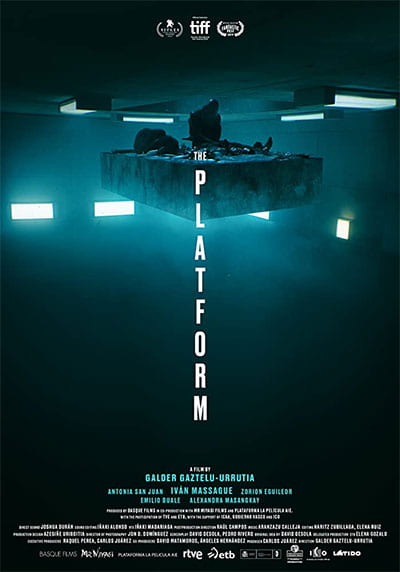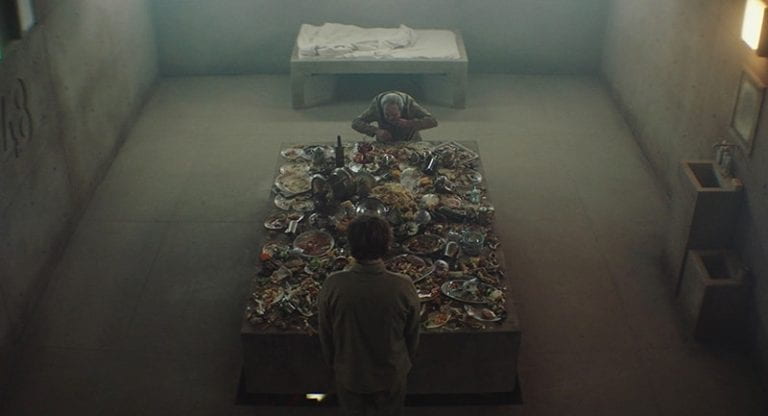
The Platform movie poster
Movies have filled more of my days than usual, even for a movie lover, during this time of COVID. Netflix and other streaming services have provided material to fill the void that would normally be time spent with friends and family, perhaps even going to movies in theaters together (remember that, those “before times”?). I have even tried to recreate some of that feeling by sharing movies with friends in VR (Bigscreen, for those who might be interested). Even before all of THIS occurred, I had a taste for bleak and harrowing movies, particularly in the genre of Horror. COVID makes it impossible to not to seek ways in which to frame the content of many movies that use themes of isolation, of struggle and survival, and of social inequities within the context of this oddly nebulous nightmare we are all currently sharing. My choice for this week’s blog post is particularly well suited to view as a moral parable with even more meaning at the forefront than it would usually have. This movie was recommended to me as “a really GOOD film, not just a “good horror”, and I must admit, it is true. I was enraptured for the entire 92 minutes of runtime of The Platform – a Spanish language Netflix Original with the original title of “El Hoyo (“The Hole”).
I will discuss the main plot point of the movie below while giving a rough synopsis that seeks to avoid giving away too many of the nuanced details or subplots. This movie easily lends itself to a more in depth analysis, and I heartily recommend that you explore this movie for yourself as well.
The movie was released just before COVID hit the US, necessitating lockdowns and quarantine time, and conveniently setting it up for a more receptive audience to truly digest its concepts than might have otherwise been possible; the movie aims to be a brutal, yet practical lesson in social economics with a side of philosophy, dressed up in blood and despair. In fact, the movie has been discussed in terms of how economists understand socioeconomics in an enlightening article in the L.A. Times. The setting is vague – futuristic, we assume, as the tech of the “platform” itself seems to be beyond what we are capable of, and certainly, OBVIOUSLY dystopian as it takes place inside of a rather unique and starkly hostile prison nicknamed “The Hole”. Hundreds of floors are contained within, with each floor containing only two prisoners. In the center of this cell that is a Brutalist vision set in cold cement, there is a hole through which we can look up or down at the numerous floors, and through which a “table”…the platform itself…passes through once each day for only a few minutes, carrying food. The plot darkens as we swiftly realize that this is in no way distributed adequately. For a few moments we are shown the exacting gourmet kitchen above providing sumptuous and splendid meals that immediately reminded me of The Cook, The Thief, His Wife and Her Lover, and with good reason it turns out, as these two movies do have a bit more in common thematically that I realized at first glance. This meal is sent down, with each level eating from the leftovers of the floor above. Needless to say, the lower you see the platform descend, the less food there is, until there is none at all…save, perhaps, for a darkly sensible yet abhorrent source. “Obvio”, to quote Trimagasi (Zorion Eguileor), who we meet very quickly after the start of the film.
Trimagasi is a denizen of The Hole, sent there as punishment for accidentally killing someone after throwing his TV out of a window in a rage. Goreng (Ivan Massagué) is his cellmate and the protagonist of the story, a man who volunteered to enter the prison to quit smoking and read a book (since everyone is allowed to bring one item), while passing the time, in exchange for an “accredited degree”. It is a pitiful situation, to realize his naivete in willingly coming to this place.
We start the film with the pair, currently on level 48. Trimagasi lays out how it works and sets up to stuff his face as the platform arrives…an unholy mess, but

Trimagasi feasts; Goreng isn’t hungry. Yet.
still relatively full of food. We learn that each month, inmates are drugged and moved around as a pair to random floors which could improve their existence or…end it. How many floors are there, exactly? The film continues to use floor level reveals to good effect as we learn exactly how far this rabbit hole goes, so to speak. Trimagasi is a menacing sort of sociopath, who brought with him a “knife that sharpens itself”. Even without having it spelled out for us at first, it is clear what exactly must happen on the floors below, where they receive no food. Trimagasi gladly enlightens us.
The morality tale inherent to the story becomes clear as day at this point – if the upper levels could only moderate their consumption, all might survive. Writers David Desola & Pedro Rivero, and director Galder Gaztelu-Urrutia unfold the story to us in each more harrowing moment, even when we see a moment where the prisoners in question have an improved lot at a higher floor. Then, we experience a twisting of the narrative towards more socially conscious and morally noble aims – an attempt to disrupt the system in a “spontaneous show of solidarity”, only to immediately question the purpose of The Hole as an experiment in how to control those who might rise against those above them. We are guided through scenes that are meant to illustrate the extreme selfishness of survival, and how that easily can veer into contempt for the needy, as we witness prisoners above defecate and urinate on those below (and the food that they eat).
Each twist in the dim and grimy prison setting illustrates the effect of social and economic inequalities starkly, painting “those above” as a metaphor for the ills of a Capitalist and consumer driven society who holds zero concern in their existence for those with less social standing, less food, less reason to live. Those above who cannot bear the waiting game to see if they remain on top or once more find the depths of the prison, often throw themselves down that hole, inadvertently providing some nourishment to those below, bringing a new level of metaphor to “eat the rich”. The upper levels (who represent those with money and power) are particularly cruel to those below them in light of the fact that many have experienced the horrors and suffering below, showing psychopathic lack of empathy and sympathy. In here, being “above” is power, and as they say, “absolute power corrupts, absolutely”.
With all of these moral lessons, and the fact that much of the dread and despair that is shown is not a beacon of special effects or monsters outside of the baseness of humanity, it is best to remember this is still in fact a horror film. A horror film that then picks up speed and takes on some semblance of an action film as it spirals into a bloody and gory mess. We see resistance to this system finally, as some of the prisoners are inspired to try and create a forced system of food distribution that would allow all to live…but only after discovering that asking nicely or appealing to the idea of unity is rejected to the sound of cruel laughter. This spiraling despair dumps us at an unfathomable depth below, leaving us to question “what just happened?” by the conclusion, leaving us perhaps dissatisfied. But truthfully, the movie has moved artfully through the metaphor to a place of symbolic hope for salvation, leaving us less dissatisfied than if it had played things out to a literal conclusion. It leaves the potentials hanging in the air for us to grasp, or grasp at, instead.
In light of the year 2020, a year full of protests, riots and calls to change our system that keeps those in power right where they like, and those below to suffer the results of their greed and hoarding of economic resources, this movie is well time, and such, very well received. Netflix has been profiting off of us, the captive audience, while telling us a parable of socioeconomic disparity. We find ourselves watching movies like The Platform, even as we see this virus decimate jobs, kill off family members, and destroy whatever tenuous financial security many Americans may have built in trying to survive against a system that is built to keep them where they are. This movie echoes our own concerns, our own fears, and is well worth watching, and spending time with, as we move forward into an uncertain future. None of us want to see ourselves in a horror movie, and The Platform is the perfect reminder that if we don’t change the path to a dystopian future, it may one day prove impossible to dig our way out of The Hole we find ourselves in.

The Feast at Level 0
